Giorni della settimana, mesi e date: Come si dicono in inglese?
Una cosa davvero utile da imparare in una nuova lingua sono i giorni della settimana e le date. Giorni e date infatti sono fondamentali per organizzare riunioni, per prenotare le vacanze e pianificare altre attività. Iniziamo quindi dai giorni della settimana.
Come imparare i giorni della settimana in inglese in ordine
É importante imparare giorni della settimana in inglese in ordine, eccoli con la rispettiva pronuncia:
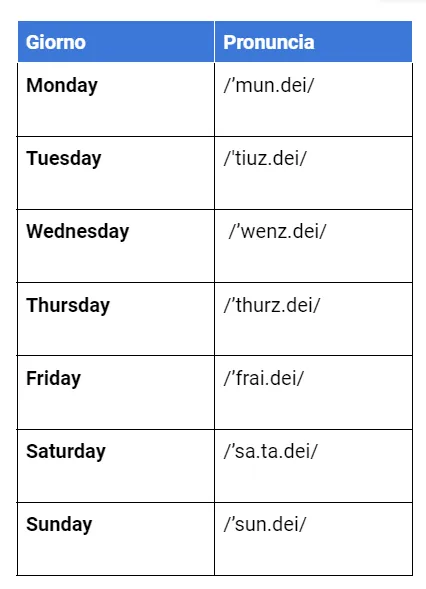
L’accento della pronuncia è sempre sulla prima sillaba, i giorni più difficili da pronunciare sono Tuesday and Thursday, quindi prenditi del tempo per esercitarti.
Come scrivere i giorni della settimana
Attenzione! per ogni giorno si usa sempre la lettera maiuscola. Ecco alcuni esempi:
- I work from Monday to Friday. I’m free on Saturday and Sunday.
- Our next lesson is on Wednesday.
- Saturday is his favorite day of the week because he plays football.
- The meeting is on Thursday at 10:30.
- We’ve got an appointment on Tuesday morning.
Come puoi notare, prima dei giorni della settimana si usa spesso on.
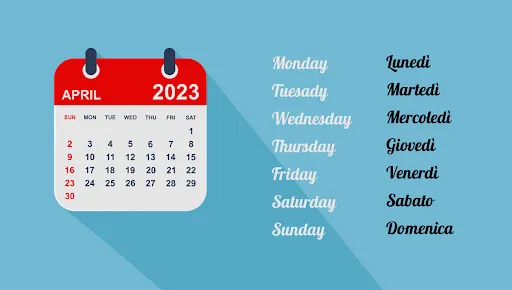
I dodici mesi dell’anno in inglese: quali sono e come si scrivono?
Come i giorni, i mesi sono termini di uso quotidiano, e quindi essenziali per avere una parlata in inglese fluente. Vediamo insieme come si scrivono e come si pronunciano:
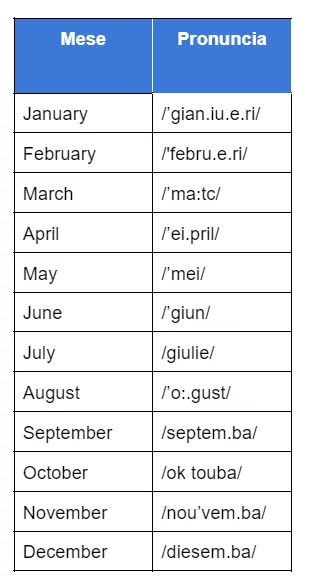
Si usa sempre la lettera maiuscola anche per i mesi dell’anno, ad esempio:
- February is the shortest month of the year, with only 28 days.
- They’re going away on holiday in May.
- The weather is very hot here in July.
- It’s very cold in December.
- Halloween is in October.
Come avrai notato, con i mesi si usa in.
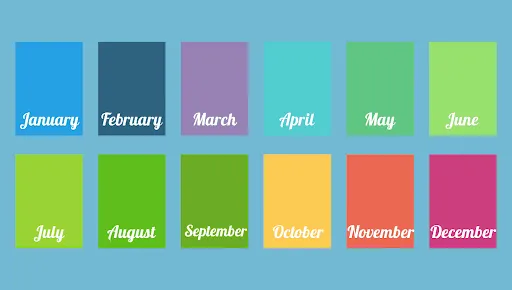
Date: come scrivere le date in inglese
Per le date in inglese solitamente si usano i numeri ordinali (first, second, third, ecc) anziché i numeri cardinali (one, two, three, ecc).
Diamo un’occhiata ai numeri ordinali:
- 1st – first
- 2nd – second
- 3rd – third
- 4th – fourth
- 5th – fifth
- 6th – sixth
- 7th – seventh
- 8th – eighth
- 9th – ninth
- 10th – tenth
- I numeri dall’11 al 19 seguono lo stesso schema con l’aggiunta di -th al numero:
- 11th – eleventh
- 12th – twelfth (la consonante v si trasforma in f)
- 13th – thirteenth
- 14th – fourteenth
- 15th – fifteenth
- 16th – sixteenth
- 17th – seventeenth
- 18th – eighteenth
- 19th – nineteenth
- I numeri che finiscono in -ty, come 20 e 30, cambiano la -y in -i e aggiungono -eth. Per esempio:
- 20 – twentieth
- 30 – thirtieth
- 21st – twenty-first
- 22nd – twenty-second
- 23rd – twenty-third
- 24th – twenty-fourth
- 25th – twenty-fifth
- 26th – twenty-sixth
- 27th – twenty-seventh
- 28th – twenty-eighth
- 29th – twenty-ninth
- 30th – thirtieth
- 31st – thirty-first
Nell’inglese britannico, per comporre la data di solito si inizia con il giorno seguito dal mese, mentre invece nell’inglese statunitense il mese di norma occupa la posizione iniziale. Lo stesso accade quando abbreviamo la data in tre numeri. Per esempio, 1st December 2017 diventa:
- 1/12/2017 in British English
- 12/1/2017 in American English.
Così come per i giorni, anche con le date si utilizza on. Ecco alcuni esempi:
- Paolo’s birthday is on June 3rd. (Pronuncia: ‘on June the third’)
- New Year’s Day is on 1st January. (Pronuncia: ‘on the first of January’)
- We’re flying back home on Tuesday, April 10th. (Pronuncia: ‘on Tuesday, April the tenth’)
- They’re having a party on 16th November. (Pronuncia: ‘on the sixteenth of November’)
- Our Wedding Anniversary is on August 11th. (Pronuncia: ‘on August the eleventh’)
Scrivere e pronunciare gli anni in inglese
In inglese, la maggior parte degli anni è suddivisa in due numeri. Per esempio:
- 1750 – seventeen fifty
- 1826 – eighteen twenty-six
- 1984 – nineteen eighty-four
- 2017 – twenty seventeen
Il primo anno di ogni secolo si pronuncia come segue:
- 1400 – fourteen hundred
- 1700 – seventeen hundred
- 2000 – two thousand
I primi nove anni di un secolo si pronunciano in questo modo:
- 1401 – fourteen oh one
- 1701 – seventeen oh one
- 2001 – two thousand and one
Possiamo fare riferimento a un decennio così:
- 1960-1969 – The ‘60s – pronuncia: ‘the sixties’
- 1980-1989 – The ‘80s – pronuncia: ‘the eighties’.
- 2000 – 2009 – The 2000s – pronuncia: ‘the two thousands’
Esempi:
- The Beatles were famous in the sixties.
- My parents got married in the seventies.
- Maradona played for Napoli in the eighties.
- Where were you living in the nineties?
- The internet became popular worldwide in the two thousands.
Come puoi notare, con gli anni si usa in.
Riepilogo delle preposizioni in inglese
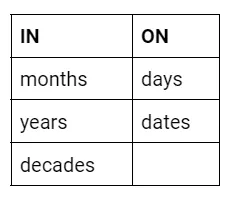
Ecco alcuni esempi:
- In my country the schools start the academic year in September.
- Is he starting the new job on Monday?
- The company was founded in 1991.
- The Wedding is on July 25th.
- There was an economic boom in the 50’s.
Attenzione, esiste un'eccezione: quando ci riferiamo ad un’occasione particolare come Pasqua o Natale si usa at. Ad esempio:
- Where will you be at Christmas? We’ll be in the mountains.
- Most people visit their families at Easter.
Consigli per memorizzare giorni, mesi e date in inglese.
Un ottimo modo per aiutarti a ricordare i nomi dei giorni e dei mesi in inglese è impostare l’inglese come lingua del tuo cellulare e/o computer. In questo modo potrai esercitarti anche guardando il calendario e l’agenda. E se sei solito tenere un calendario appeso al muro o sulla scrivania, a casa o al lavoro, la prossima volta compralo in inglese. È un modo semplice ma efficace per fare pratica.
Ora che sai dire giorni e date in inglese, sei pronto per organizzare riunioni e vacanze!